8 Pros and Cons of Redmi Note 13 Pro 5G
Introduced to the global market in January 2024, the Redmi Note 13 Pro 5G is a member of the Redmi Note 13 Series. This device has quickly garnered attention as a compelling option in the mid-range smartphone category.
The Redmi Note 13 Pro 5G becomes a strong contender in its price range. However, like any product, it comes with its own set of strengths and weaknesses that are worth considering.
For those interested in understanding both sides, here are the pros and cons of the Redmi Note 13 Pro 5G, which we will explore in detail.
Pros of Redmi Note 13 Pro 5G
Given the price, this phone is an excellent choice for a mid-range smartphone. Xiaomi consistently packs its phones with robust features across all areas. Below are some key advantages of this model.
1. Appealing Design and Reliable Durability

The Redmi Note 13 Pro 5G features an increasingly sophisticated design. It has a stylish look, combining glass on the front and rear surfaces in a range of striking colors.
The rear design is sleek yet contemporary, featuring a square camera module neatly divided by a slim, defined line around each camera lens. The phone’s flat silhouette enhances its modern appeal.
Available in three elegant colors—Midnight Black, Ocean Teal, and the signature Aurora Purple—I find the Aurora Purple particularly appealing.
Unlike the other options, it presents a unique color scheme in the camera module, displaying shades of pastel blue, pink, and green, which are subtle yet distinctive. For someone who appreciates muted tones, the Aurora Purple is an ideal choice.
Beyond its looks, the Redmi Note 13 Pro 5G is designed for comfort and ease of use. It boasts a compact form, measuring 161.2 x 74.2 x 8 mm and weighing just 187 grams, making it easy to handle.
In terms of durability, the device is equipped with IP54 certification, ensuring it is resistant to dust and splashes of water from any direction. This makes it suitable for outdoor use in light rain, although it is not designed to be submerged in water.
Moreover, the rear glass is fortified with Gorilla Glass Victus and the corners are reinforced with a composite aluminium frame, enhancing its resilience. The smartphone has undergone rigorous testing, including pressure, drop, and impact tests, and has been proven durable with USB connections tested up to 10,000 uses.
2. Bright AMOLED Screen and Thin Bezels
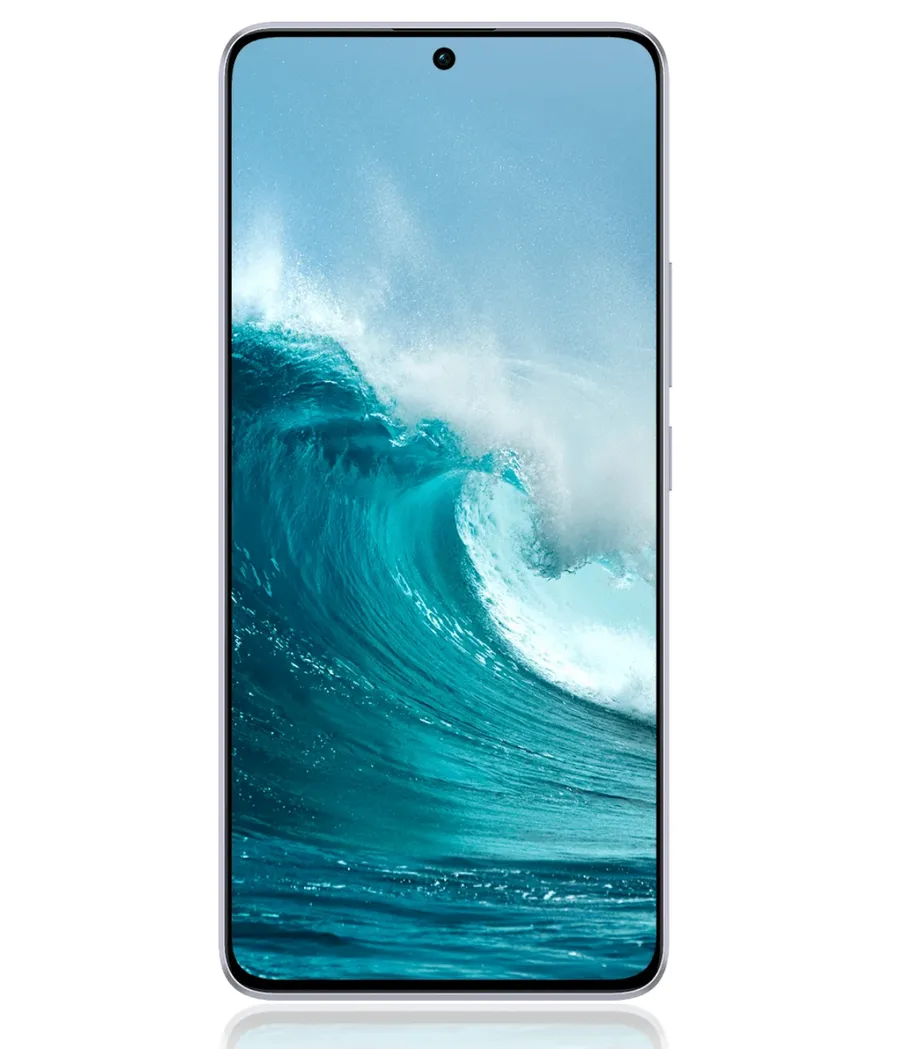
The Redmi Note 13 Pro 5G boasts an impressive display that matches the performance of its sibling, the POCO X6. It features a spacious 6.67-inch AMOLED panel, which enhances viewing with its slim bezel design, making the screen appear even larger.
This model achieves an impressive screen-to-body ratio of 89.8 percent that gives immersive experience with ultra-clear visuals. The AMOLED panel boasts a 1.5K CrystalRes display, with a resolution of 1220 x 2712 pixels, bridging the gap between Full HD+ and WQHD+ resolutions while maintaining power efficiency comparable to Full HD+.
The display also adapts its refresh rate between 60 Hz and 120 Hz, based on user activity, enhancing both performance and efficiency.
For energy savings, users can manually set the refresh rate to 60 Hz, although this reduces the smoothness of animations compared to the 120 Hz setting.
According to GSMArena, the lowest refresh rate, 30 Hz, is only used when the device is in Always-on-display mode, and even then, it only remains active for 10 seconds.
Further enhancing its gaming credentials, the screen includes a high touch sampling rate of 2160 Hz and 16x super resolution touch control, greatly speeding up touch responsiveness—ideal for fast-paced competitive games.
The device also supports a broad range of colors, displaying up to 68 billion colors, and features Dolby Vision for high-definition video streaming, with peak brightness reaching up to 1800 nits. It is protected by robust Gorilla Glass Victus.
For eye comfort, the Redmi Note 13 Pro 5G includes an eye protection feature that adjusts screen brightness up to a 1920 Hz PWM dimming rate, making it safer to use in low light conditions.
Additionally, it holds several TUV Rheinland certifications, including for low blue light, being circadian friendly, and flicker-free technology.
3. Powerful Snapdragon 7s Gen 2 Performance

Upon its September 2023 release in the Chinese market, the Redmi Note 13 Pro 5G was the first to feature the newly introduced Snapdragon 7s Gen 2 chipset, maintaining this hardware in its global release.
This variant of the Snapdragon 7 Gen 2, denoted by the 's', offers slightly reduced CPU and ISP capabilities of the GPU, making the device more budget-friendly.
The Snapdragon 7s Gen 2 is manufactured by Samsung with a 4 nm process and includes eight CPU cores: four Cortex A78 cores at 2.4 GHz for performance and four Cortex A55 cores at 1.95 GHz for efficiency. It also features an Adreno 710 GPU.
Performance benchmarks reveal that the Snapdragon 7s Gen 2 scores up to 576,890 points on AnTuTu v10, according to Nanoreview.
GSMArena's tests show a slightly higher score of 581,979 points, although it falls short of the POCO X6 5G's 605,803 points with the same chipset. GeekBench 6 scores are 1019 for single-core and 2751 for multi-core.
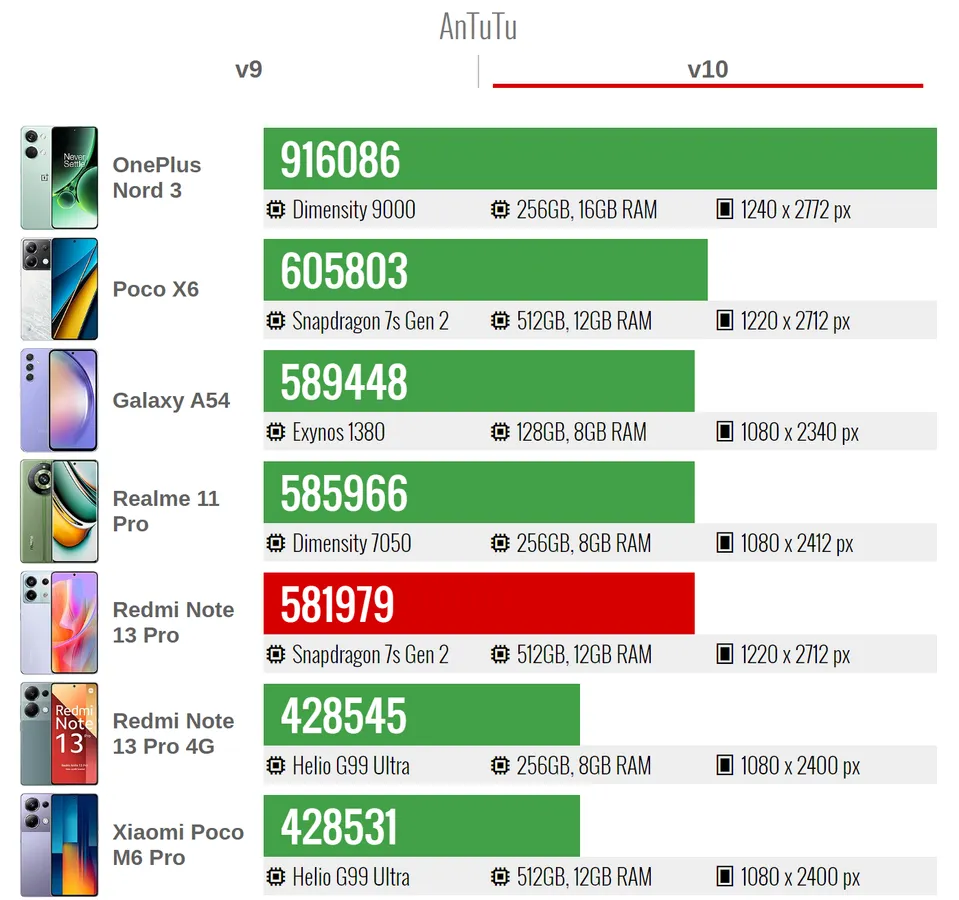 Source: GSMArena
Source: GSMArena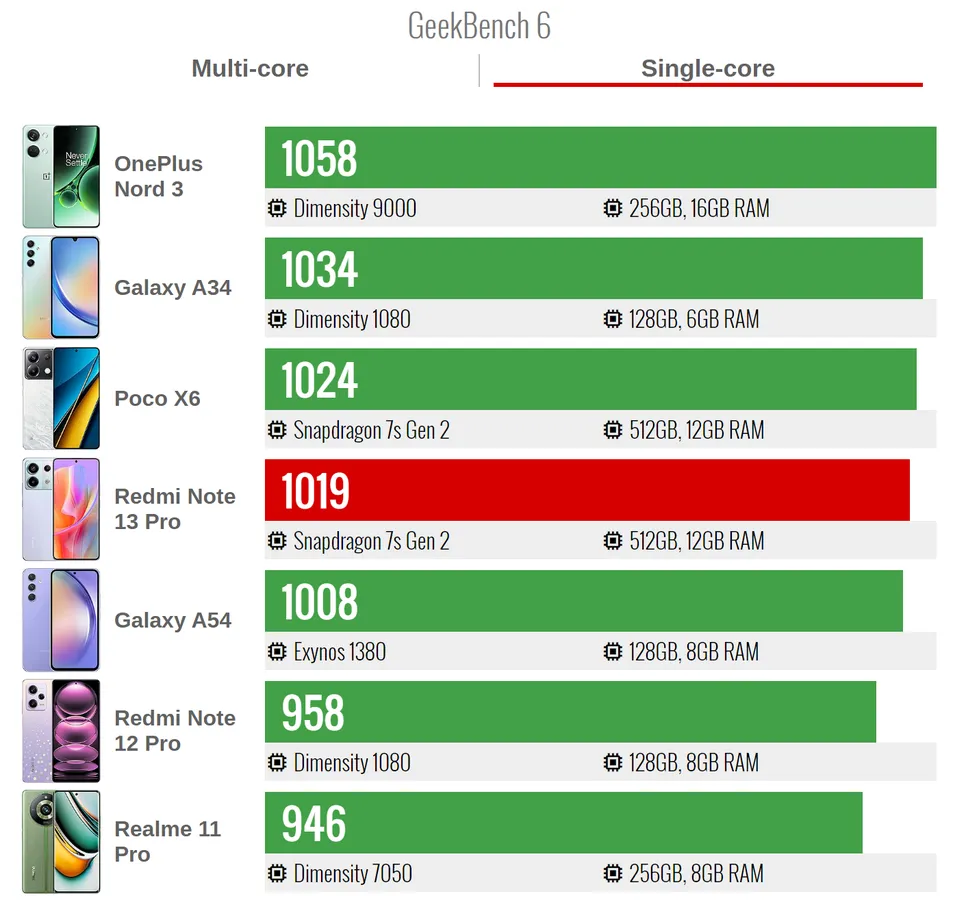 Source: GSMArena
Source: GSMArena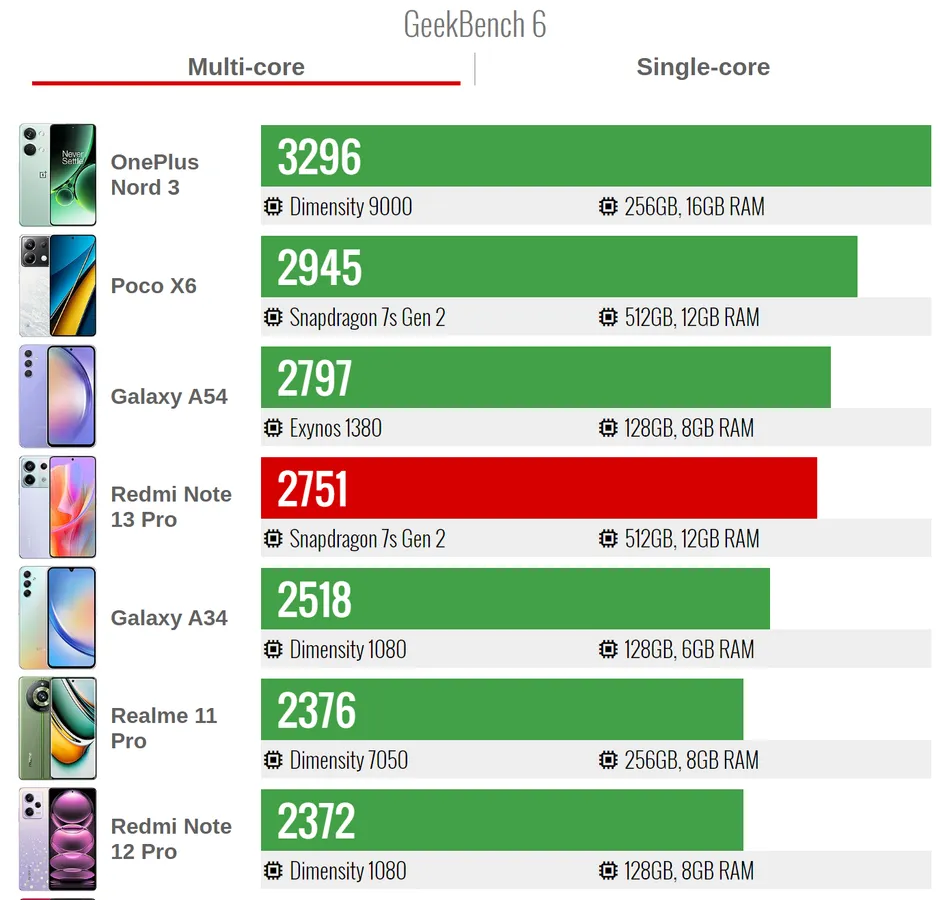 Source: GSMArena
Source: GSMArenaWith variations stated by different reviewers, such as Zeibiz, it recorded an AnTuTu v10 score of 601,659 points.
Despite not being the top performer compared to the POCO X6 5G, the Redmi Note 13 Pro 5G demonstrates considerable stability in performance, maintaining 70 percent CPU and 99 percent GPU efficiency during tests.
The device's performance is also bolstered by its memory options that offers 8 GB or 12 GB LPDDR4x RAM and 256 GB or 512 GB of UFS 2.2 internal storage.
It also allows for memory extension up to an additional 12 GB, achieving a potential total of 24 GB RAM. However, it lacks a microSD slot, so users need to choose their storage capacity wisely.
4. Superior Camera Capabilities with 200 MP

The Redmi Note 13 Pro 5G is equipped with a remarkable 200 MP main camera, boasting an f/1.7 aperture, a 23mm focal length, and a sizable 1/1.4-inch sensor. This setup is enhanced by multi-directional PDAF and Optical Image Stabilization (OIS), ensuring sharp and stable images.
This camera's advanced features include 16-in-1 pixel binning technology and Super QPD, which contribute to faster and more precise autofocus, complemented by a 7P lens coating.
Additional functionalities enhance photo quality further, including portrait mode with beautify, night mode, Pro Mode, HDR, AI SkyScraping, Magic Cutout, and more.
Additionally, the ultrawide secondary camera offers 8 MP resolution and a 118-degree field of view. There’s also a 2 MP macro camera, which serves as a supplementary feature.
Interestingly, the camera's capabilities closely resemble those of the higher-end Redmi Note 13 Pro+ 5G. Tech Spurt highlighted in a review that both models share the same camera hardware, resulting in similar image quality.
Reviewers have noted impressive detail and color contrast, particularly in night mode, which effectively minimizes flare and preserves detail. However, capturing moving subjects still presents a challenge, often resulting in blurred images regardless of lighting conditions.
Conversely, GSMArena expressed disappointment with the 200 MP main camera, noting no significant improvement over standard resolution modes in terms of capturing additional details.
 Source: GSMArena
Source: GSMArenaDespite this, the camera excels in daylight conditions, displaying excellent detail, color contrast, and dynamic range. The ultrawide camera, however, does not perform as well, often producing images that lack detail and exhibit a limited dynamic range.
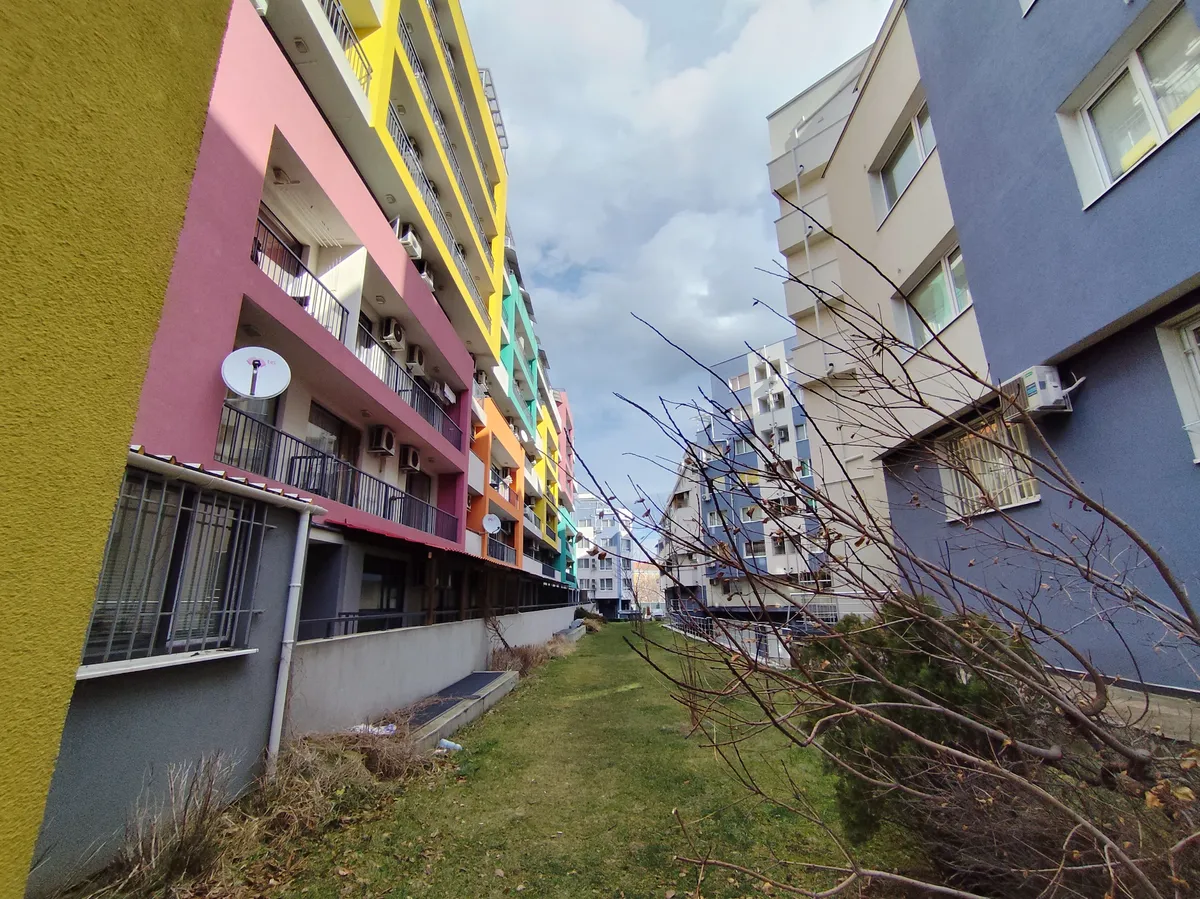 Source: GSMArena
Source: GSMArenaPortrait mode, on the other hand, performs commendably within its price range. Despite some loss in detail, photos maintain good overall quality with neat separation between the subject and background.
 Source: GSMArena
Source: GSMArenaIn low-light conditions, the Redmi Note 13 Pro 5G proves quite capable, enhancing detail and sharpness while maintaining good color contrast.
 Source: GSMArena
Source: GSMArenaRegarding selfies, the 16 MP front-facing camera produces decent, if unspectacular, results. The colors and contrast may appear somewhat subdued, but the images retain a pleasing natural quality.
 Source: GSMArena
Source: GSMArenaVideo recording capabilities of the rear camera include 4K at 30 fps and 1080p at either 60 fps or 120 fps for slow motion, supported by effective gyro-EIS stabilization. The front camera, however, is limited to 1080p at 60 fps and lacks stabilization features.
5. Stereo Speakers and Comprehensive Connectivity

The Redmi Note 13 Pro 5G boasts stereo speakers that deliver robust sound quality. It supports both HiRes & HiRes wireless audio technology, ensuring high fidelity sound even when using wireless devices. For those who prefer traditional earphones, the phone includes a 3.5mm audio jack.
The phone's connectivity options are extensive and advanced. It supports dual-band WiFi and Bluetooth 5.2, enabling efficient management of internet usage across different network bands.
Additionally, NFC technology is incorporated, expanding its usability for digital transactions, e-money balance checks, and even as a hotel room key. The phone also features infrared and USB Type-C ports, maintaining Xiaomi’s standard for connectivity options.
6. Fingerprint Sensor Under the Screen

One great feature of the Redmi Note 13 Pro 5G is its under-display fingerprint sensor, which lends the device a more upscale appearance, akin to the higher-end Redmi Note 13 Pro+ 5G.
The sensor is conveniently placed near the thumb’s natural resting position, enhancing ease of access. Additionally, it responds quickly to unlocking commands, which is impressive for a smartphone in this price range.
The Redmi Note 13 Pro 5G also has a comprehensive set of sensors, including an accelerometer, compass, and gyroscope—features particularly favored by gamers. However, its proximity sensor is software-based, which may result in slightly slower responsiveness compared to hardware-based sensors.
7. Equipped with 67W Fast Charging
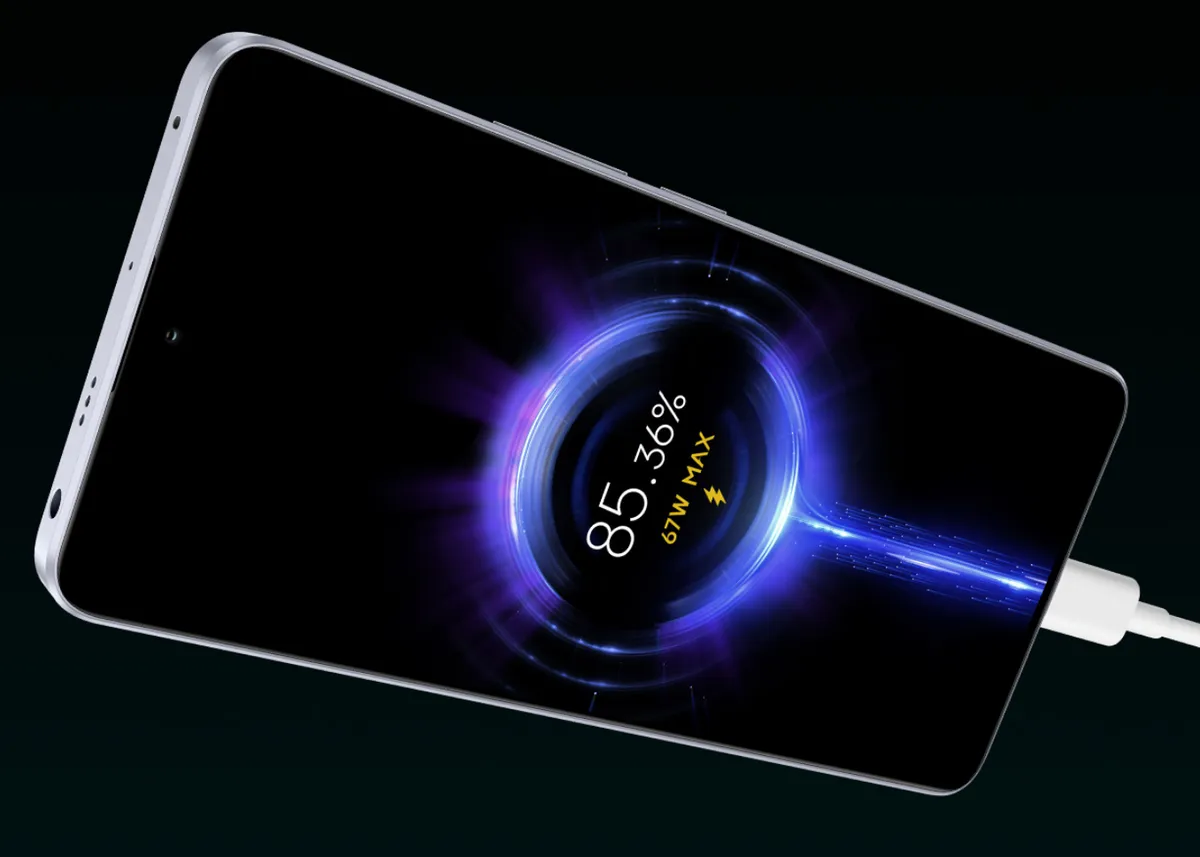
The Redmi Note 13 Pro 5G features 67W Turbo Charging technology, which, while not as fast as the 120W charging in the Redmi Note 13 Pro+ 5G, still offers a significant improvement over the 33W charging of the standard Redmi Note 13.
This charging capacity mirrors that of the previous model, the Redmi Note 12 Pro, though it charges more rapidly. According to tests by GSMArena, the Redmi Note 13 Pro 5G can recharge up to 83% in just 30 minutes, and a full charge takes around 42 minutes.
In comparison, the Redmi Note 12 Pro reaches 78% charge in 30 minutes and requires approximately 55 minutes to fully recharge.
8. Already Equipped with eSIM, a Rarity in its Price Range

One of the distinguishing features of the Redmi Note 13 Pro 5G is its support for eSIM technology. As of early 2024, it is rare to find eSIM functionality in mobile phones priced around USD 300 . Typically, eSIM is reserved for flagship models priced above USD 500.
The inclusion of eSIM technology at this price point sets the Redmi Note 13 Pro 5G apart from its competitors. The closest rival with eSIM capability is the Samsung Galaxy A55 5G, which is priced at around USD 370.
An eSIM is integrated directly into the phone, rather than being a removable card. With dual SIM slots also available, the Redmi Note 13 Pro 5G offers the flexibility for users to operate up to three SIM cards simultaneously, enhancing connectivity and user convenience.
Cons of Redmi Note 13 Pro 5G
Despite offering several attractive features for its price range, the Redmi Note 13 Pro 5G does have its share of drawbacks. These limitations are somewhat expected given its affordable price point. Here are some drawbacks of the Redmi Note 13 Pro 5G.
1. Operating System and Interface
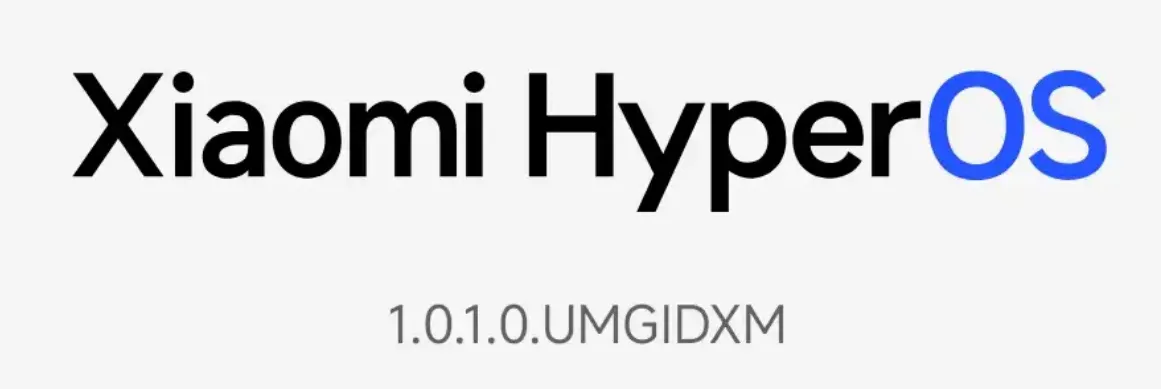
The Redmi Note 13 Pro 5G initially ships with Android version 13 and the MIUI 14 interface. It appears that this model may be among the last Xiaomi devices using the MIUI interface, as the company begins transitioning to its new HyperOS system, starting with the POCO X6 Series launched in February 2024.
Users of the Redmi Note 13 Pro 5G will eventually receive an upgrade to HyperOS. Initially, however, they will operate under the MIUI 14 system.
Additionally, the choice of Android 13 in 2024 seems a bit dated, especially since many competing phones are already equipped with Android 14 upon their release.
The Redmi Note 13 Pro 5G is slated to receive updates up to Android 16, spanning a three-year upgrade period. Although this is relatively generous, it effectively aligns with other devices that offer two years of support but start with Android 14.
Moreover, according to GSMArena, the Redmi Note 13 Pro 5G's software suite includes numerous unnecessary pre-installed apps. Some of these apps frequently generate distracting and unclear notifications.
2. Lack of MicroSD Slot
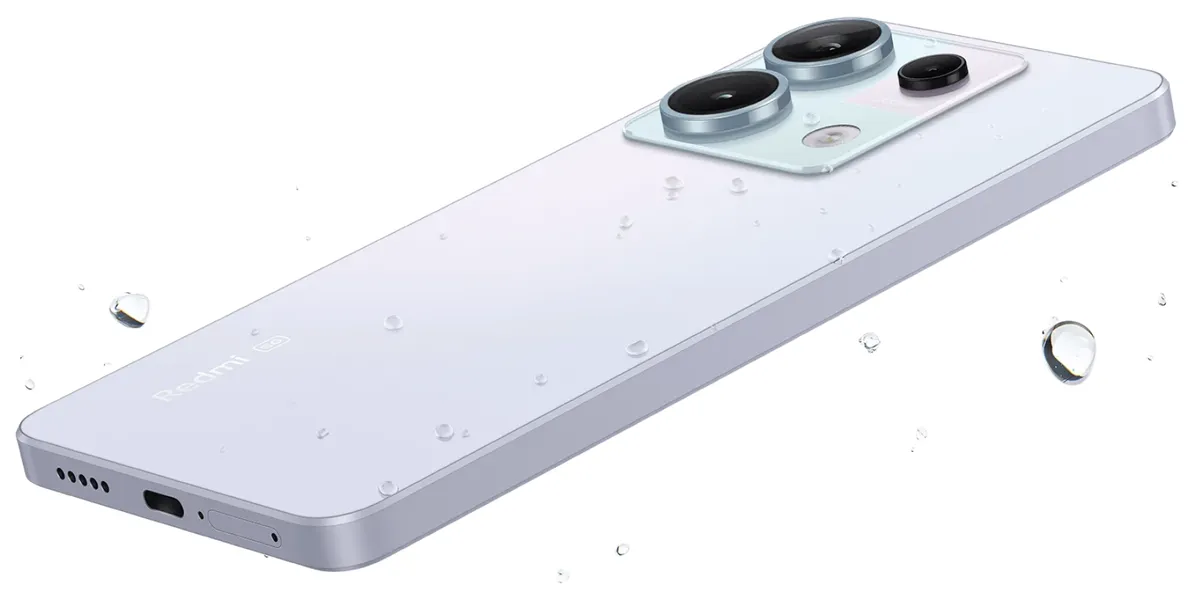
Another limitation of the Redmi Note 13 Pro 5G is the absence of a microSD slot, which is somewhat atypical for Xiaomi, especially within the budget-friendly mid-range category.
Although the Redmi Note 13 Pro 5G comes with substantial internal storage options—256 GB and 512 GB—it would be beneficial to have the flexibility to expand storage capacity. Similarly, while the device offers 8 GB and 12 GB of RAM, with the possibility to extend this up to 12 GB, the lack of a microSD slot restricts the overall potential for memory expansion.
3. Battery Life Could Be Better

Another limitation of the Redmi Note 13 Pro 5G is its underwhelming battery performance. Despite being the only model in the series equipped with a 5100 mAh battery—the Redmi Note 13 5G and 13 Pro+ 5G both have 5000 mAh batteries—its performance does not meet expectations.
The Redmi Note 13 Pro 5G is advertised to support extensive use, boasting up to 11 hours of gaming, 16 hours of video playback, 136 hours of music playback, and up to 15 days on standby. However, these claims do not entirely align with real-world tests.
According to GSMArena, the device achieved an average battery life of 10 hours and 16 minutes, with specific performances of 26 hours and 31 minutes for calls, 11 hours and 50 minutes for video playback, 9 hours and 24 minutes for web browsing, and only 6 hours and 9 minutes for gaming.
These results are disappointing, particularly when compared to its rival, the POCO X6 Pro 5G, which has a 5000 mAh battery but manages an average of 11 hours and 46 minutes. Even the previous generation, the Redmi Note 12 Pro 5G, also with a 5000 mAh battery, outperforms the newer model with a battery life of 12 hours and 8 minutes.
Conclusion
The Redmi Note 13 Pro 5G is highly anticipated and expected to be a strong contender in the mid-range smartphone category given its price.
The phone features a stylish design with beautiful pastel colors and is built to last, boasting IP54 certification for durability. It also maintains a comprehensive set of ports, including a 3.5mm audio jack and stereo speakers.
Additionally, the device is equipped with a high-quality AMOLED display and supports various advanced features that enhance user experience while ensuring comfort. Despite its substantial 5100 mAh battery capacity, the battery life remains a point of criticism.
Performance-wise, the Redmi Note 13 Pro 5G is powered by the capable Snapdragon 7s Gen 2 and offers ample memory for multitasking and gaming. The 67W fast charging capability allows for a quick recharge, typically under an hour.
Nonetheless, the Redmi Note 13 Pro 5G is not without its flaws. The absence of a microSD slot and the continuation of the MIUI 14 system, which is laden with pre-installed apps and intrusive advertisements, detract from the user experience. Although an upgrade to HyperOS is promised, the current MIUI version may frustrate users.
Given these pros and cons, are you still looking forward to the release of the Redmi Note 13 Pro 5G in Indonesia, or might you consider other models with comparable features? Feel free to share your thoughts and reasons in the comments section.
